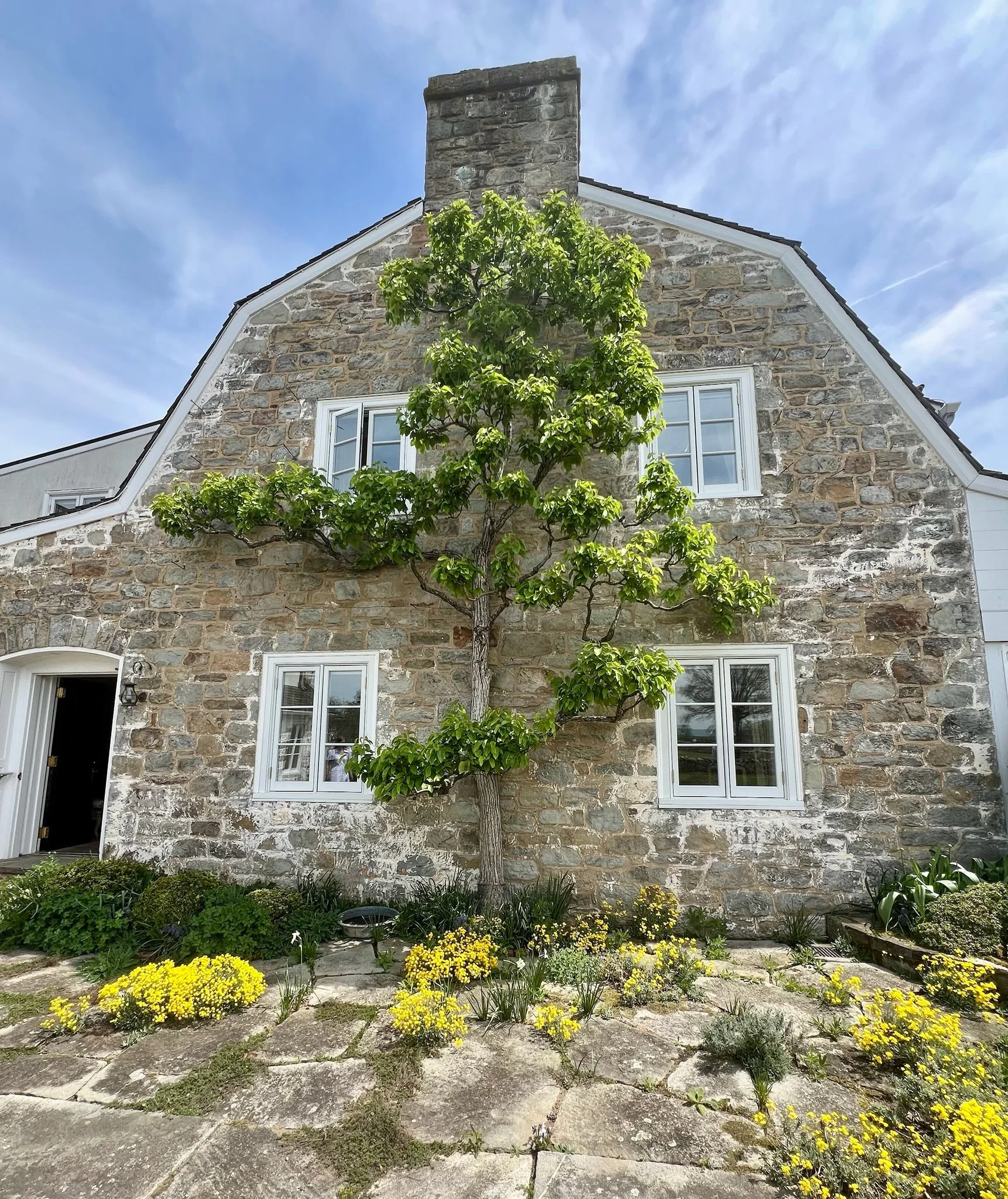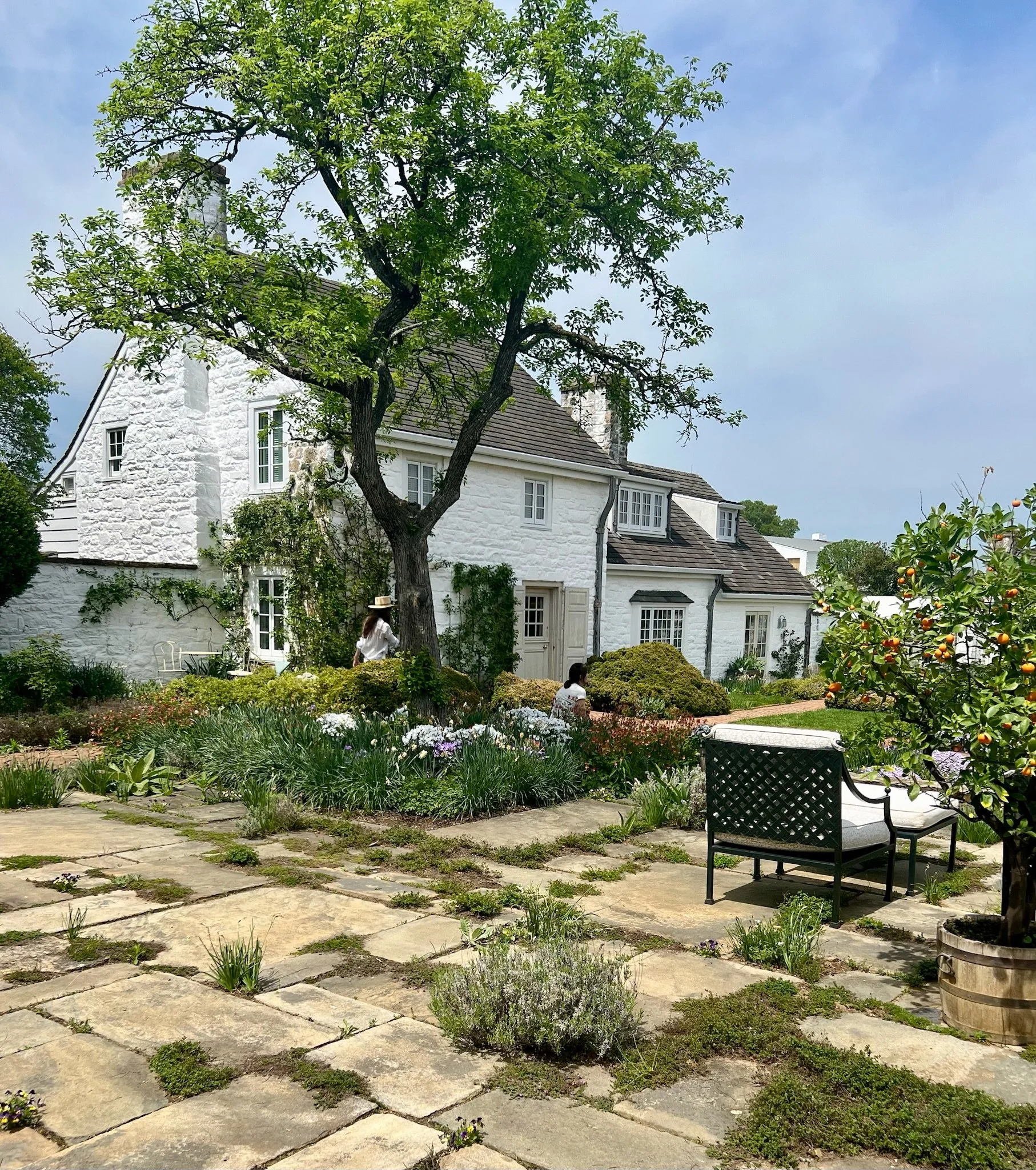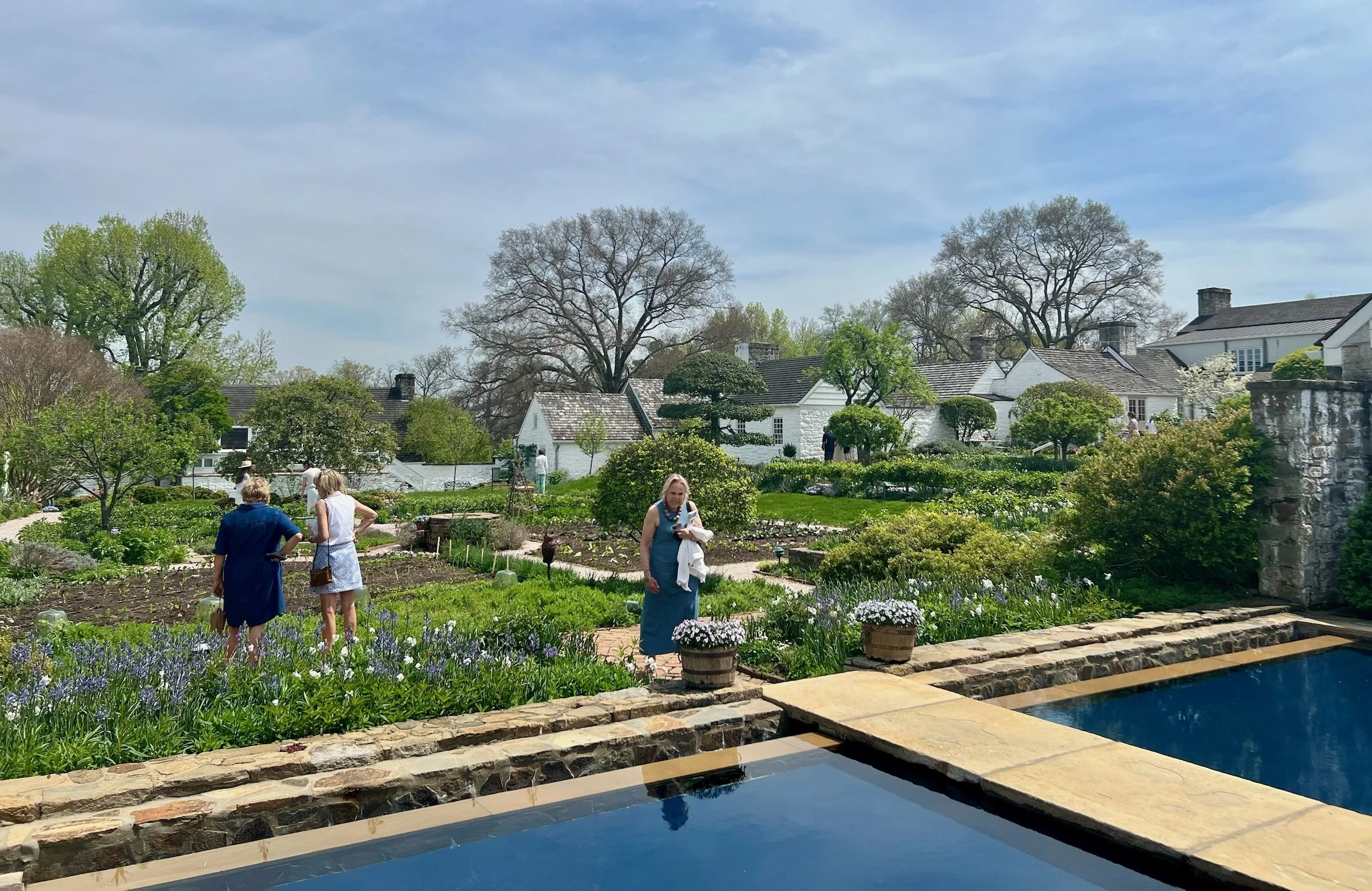Lessons from Bunny Mellon’s Garden
Bunny Mellon’s gardens feel like fairy tales. Plants are growing up out of stones, flowers bursting from beds, and trees are twining up castle walls. They are full of life and story. They are full of color. They are magic. I invite you to take a moment to stroll through with me.
I am so happy I heeded the advice of a dear friend. She knew I would love visiting the abundant gardens created by Bunny Mellon in Upperville, Virginia. Oak Spring is Bunny Mellon’s personal garden where she blended the beloved fairy tales of her childhood and brought her exquisite sense of color to bear. If Breakfast at Tiffany’s went to Narnia and came back dancing with jewels and a straw tote, this is Bunny Mellon. You are completely transported to her imaginative use of plant combinations and her love of inviting birds into her garden. I can’t even begin to describe the unusual pruning techniques and plants she used to create espaliered apple trees and witch hazel shrubs to enliven the walls of her home. Bunny Mellon’s gardens are truly special. They have the feeling that the gardener has not held back and danced with Mother Nature in her own way. If you are intrigued, there is a garden tour in June for two days only.
I’m not the only one to fall in love with Oak Spring. In the late 1950s, Jackie Kennedy came to visit for tea. After her first visit asked Bunny to redesign her own home garden. They became dear friends, and Jackie had her own cottage on the property. She asked Bunny to design the White House’s new Rose Garden in 1962. She went on to design Jackie Onassis garden in Martha’s Vineyard and Hubert de Givenchy’s garden in France. She also helped to restore Louis the XIV’s garden in Versailles, a dream commission inspired by her life long love and study of French pruning techniques. This was only a smattering of gardens she created, and you can read more here if you are curious. She later founded Oak Spring Foundation to cultivate horticultural scholarship and public access to her estate. You can visit or apply for a residency program, or take classes to inspire your own love of nature. Truly an ever living gift from Bunny Mellon to us to keep growing and celebrating art.
My husband and I visited Little Oak Spring and drove through the rolling countryside of Upperville, Virginia. Low stone walls followed the lay of the land as we approached the estate. We spent hours walking her gardens and soaking in the uniquely gifted hand that touched the land around her. I felt as if she would walk up any minute, pruning shears in hand, to explain how it was done. I felt as if I could hear her voice encouraging me to dream of new ways of seeing. Her garden spoke to me of the groundedness of stone courtyards. Flowers and vines exalting up and over walls spoke to me of taking flight and trying new things. In all the living things in her garden, you hear her voice.
“If ‘gardening is a way of thinking, as Bunny Mellon once wrote, then her garden at Oak Spring was her journal writ in plantings and pathways. Of all the gardens she created in her lifetime, this half-acre space was her most personal. It grew as she did, and was a place where she experimented over the years of her long life with color, texture, and form.” -Little Oak Spring Foundation
I loved seeing some of my own favorites in her garden and took so many pictures of her water features, plant combinations, espaliered apple trees, and stone patio. I bought a book about her gardens and poured over the pictures. When I returned home, I began reflecting on the unique gifts of Bunny’s life and garden. I was feeling inspired to write in my own journal. What did I take home with from her gardens?
Paint with your own Brush
From a young age, Bunny followed her own muse. At the age of six she asked for her own garden and was given an area to cultivate. She began creating a library of gardening books at the age of 10, and collected rare books in French about pruning techniques. She also collected Fairy Tales that inspired her love of the magical, the whimsical and the unexpected. The Olmstead Brothers, well known pioneers of Landscape Architecture, were hired to design the family gardens. She asked to shadow them and was allowed to listen to genius at work.
Bunny admired the masters and she listened to the greats. Ultimately, she felt this inner confidence to create something different unexpected and beautiful. For example, her front cart courtyard was carefully selected out of local stone. Instead of adding mortar between the stone, she decided to leave the joints open and wide enough to accommodate lean soil that mimic the soil found on her Mediterranean travels. She like to call the stone courtyard her Mediterranean garden. There you will find plants used to the lean, dry soils of Mediterranean gardens. Growing in between the cracks were silvery Santolina , Creeping Thyme, and Lavender, and then some beautiful little volunteer Violas that would pop its way up through the stones. Bunny did not consider these weeds. She loved the look of a map of nature meandering its way through her courtyard.
Play. Don’t be afraid to Experiment
Bunny Mellon was inspired by classic garden design, and used structure as the jumping off point for her flights of fancy. She was drawn to the gardens of Versailles, and used similar geometry to form pathways and garden beds. She was captured by the clipped and contorted shrubs at Versailles, but she interpreted form in her own way. Instead of using evergreen shrubs to create structure, she used the geometry of rectangular beds within the courtyard. I noticed there were very few evergreen shrubs in her garden other than a few boxwood. Instead of evergreen shrubs, her garden is mainly composed of fruiting trees, trees with berries, and blooming shrubs and perennials to lure in the birds with berries, apples or other fruits. She was captured by the idea of espalier or pruning plants to grow along a wall or structure. Enamored of apple trees, crabapple trees, and witch hazel shrubs, she trained those into what appears to be vines tied to the brick walls of her home. She created a story book entrance in her front courtyard where a stately apple tree comes to rest just outside her second story window. She had her gardeners install a spike where she would place an apple for the birds to feast upon, and see them close up. I imagined Snow White and Rapunzel gazing up at her window, and seeing her arms resting on the window sill, communing with her bird friends. She was entranced with sculpting nature, and how each branch could be a living work of art. She wanted to live among her trees, and be a bird on a perch.
Have FUN with Color
Bunny let her love of color infuse every part of her life. From her clothes, to her jewelry, to her garden her uncanny way of mixing colors “just so” was a gift. I enjoyed talking to many of the gardeners on staff who told me Bunny never met a weed. If she loved a bloom, she planted it in her garden. For example, she deliberately sprinkled native orange Columbine into her gardens for the bright color and lantern-like blooms held on wispy stems. She did not choose to create a garden of static sophistication like in Versailles. She used the principles of organization for her garden and then let her painter’s palette fly! It’s as if she was inspired by the impressionist artists to paint dots of color using mainly perennials in her garden, and captured each individual painting in the framework of rectangular planting beds in her courtyard. Bunny‘s garden is like a living bouquet. She has every sort of perennial, artfully, mixed and shining in jewelbox tones in the sunny courtyard as well as in shady or nooks. The water element sings in shades of blue in Bunny’s garden. Twin reflecting pools are painted turquoise blue and seem bottomless…but they are not deep at all! They reflect the colors of the gardens and the sky above to great effect.
We are at our most creative when we feel well supported.
From a young age, Bunny Mellon was well supported by her family to follow her passion for creating gardens. Certainly, she had all of the resources of a privileged upbringing. However, her family intentionally gave her access and support, unusual for a young woman of her time. What can we create when we are well-resourced? What can we create when we have the support of our family, our school, and our community? What do we gain when everyone has access and resources to let our imaginations run free? I couldn’t help thinking about the importance of libraries, teachers, schools, and community art programs to foster creativity. What happens when that support disappears? Right now it seems important to keep supporting our local places of gathering and supporting creativity of all types. This is where hope lives and future solutions are born.
Bunny learned from the masters. She was encouraged to listen, experiment, and explore. Ultimately, she synthesized what she learned to express her unique creative vision of color and form that continues to support and inspire everyone who visits to create their own magic. I wish for you the opportunity to create magic of all sorts in your own unique way.
-See you in the garden! Wendell



